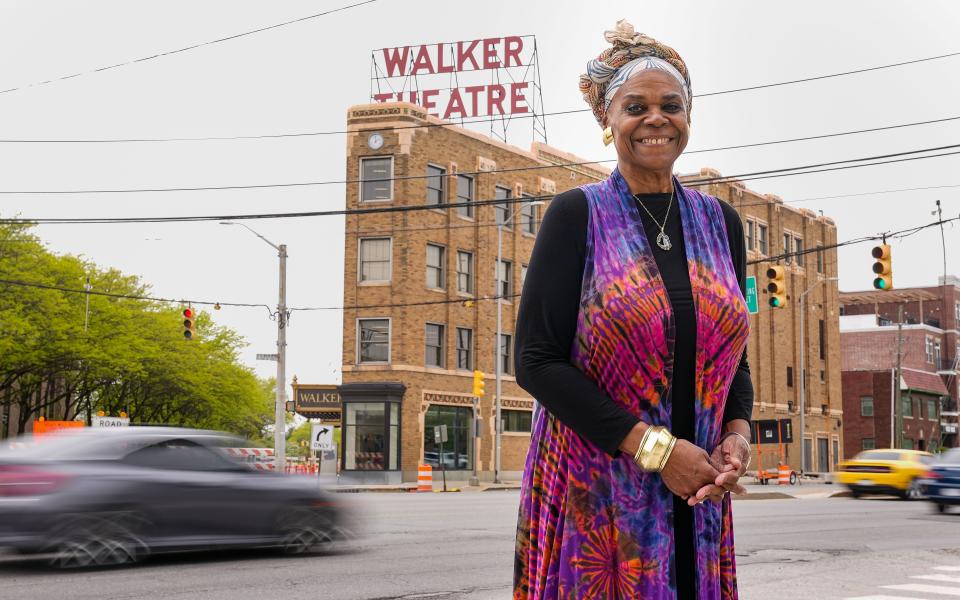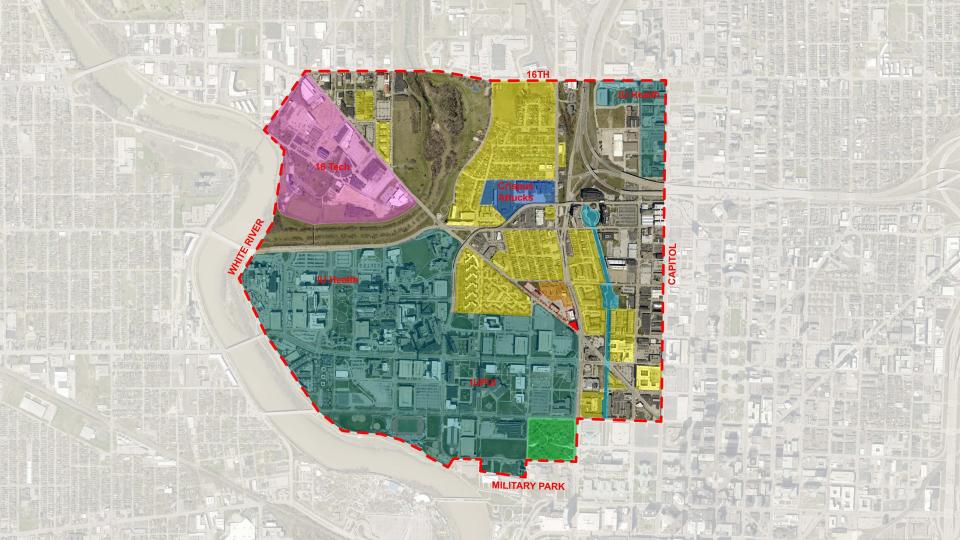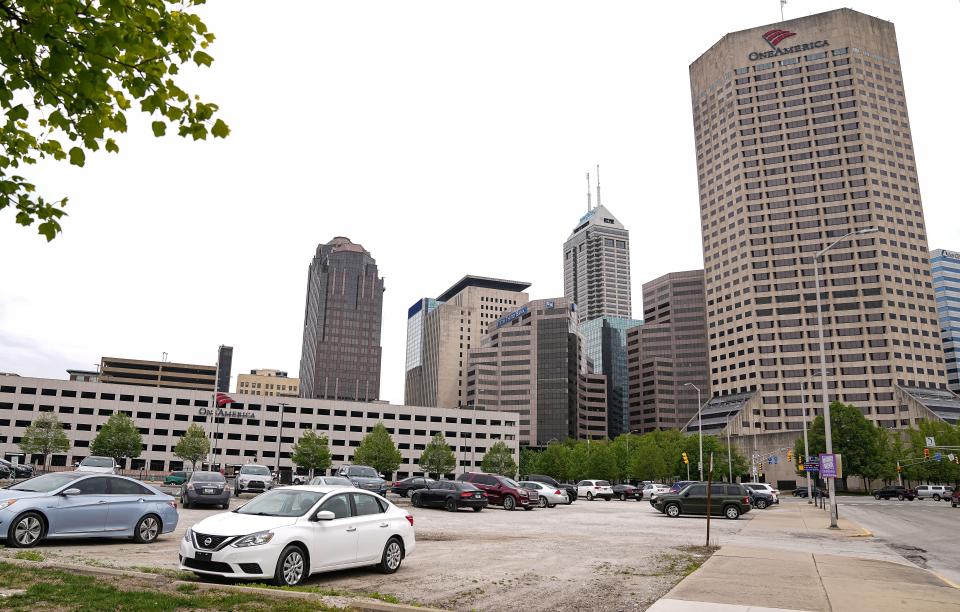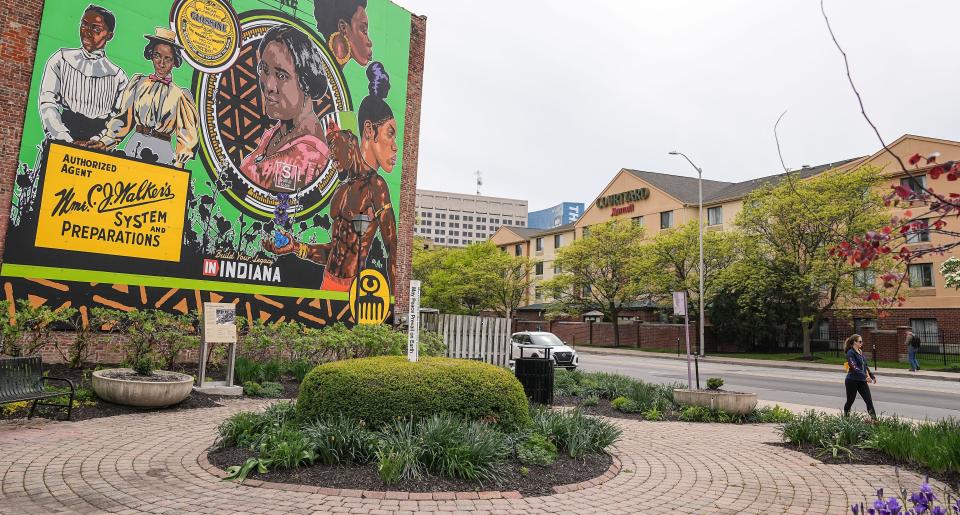‘A place of joy:’ Black community hopes Indiana Avenue project embraces thriving past
Candyce Offett has deep roots on Indiana Avenue.
She lives in a historic home in Ransom Place, where her family has lived for four generations. Decades ago, her grandparents ran a variety store in a now-shuttered building near her house, and most of her neighbors are her extended family.
Offett grew up hearing stories about the Indiana Avenue of old, a thriving center of music, commerce and culture for the Black community in Indianapolis in the 1940s, when her grandparents moved to the Avenue.
"My grandfather actually owned a cleaners on the Avenue so I heard about that," she said. "And it just being a hustle and bustle place that Black people used to go and hang out and go out and just be together."
Offett, who's 35 and the president of the Ransom Place Neighborhood Association, never knew the Indiana Avenue her grandparents did. By the time she was born, urban renewal — including the I-65 highway, IUPUI and new downtown skyscrapers — reduced what was once a vibrant corridor to mostly-vacant buildings and parking lots, placeholders for development that never emerged.
More: Indiana lawmakers pledged to force hospitals to lower prices. The results are mixed.

Now, though, Offett sees a bright future for Indiana Avenue, a walkable and vibrant community in line with the area in its heyday.
This dream may soon become a reality as the Avenue poises for redevelopment. In February, the city’s Department of Metropolitan Development invited consulting firms to submit ideas for Indiana Avenue's redevelopment in the form of a Request for Expressed Interest. The downtown area included in the strategic plan is bounded by 16th Street to the north, Capitol Avenue to the east, Military Park to the south and White River to the west.
The city hopes to revitalize Indiana Avenue through an equitable strategic plan, in concert with the efforts of groups Urban Legacy Lands Initiative (ULLI) and Reclaim Indiana Avenue.

Neighbors and stakeholders see the city’s plan as an opportunity to reverse decades of wrongdoing and disinvestment caused by racism and disregard for the vibrant Black history on Indiana Avenue. And, they are adamant that community involvement is necessary for the next steps.
Housing and transportation
Most stakeholders want more housing, specifically mixed-use buildings, with businesses and retail on the ground level and apartments above, rather than ground-up apartments. The Request for Expressed Interest indicated that developers should have a commitment to reviving the history of Indiana Avenue and to building “new affordable, urban, ‘missing middle’ and mixed-use housing.”
When Claudia Polley, Indianapolis local and ULLI president, envisions a thriving Indiana Avenue, she thinks of one thing: people strolling up and down the streets, whether they be visitors or neighbors.
“Indiana Avenue used to be a place of joy,” she said. “In one way or another and whether it was long term or short term, whatever, but it used to be a place that people came to, and smiled and enjoyed and lived. And we think it should be that way again.”
More: Artist and portrait revealed for two-story mural celebrating Indy poet Etheridge Knight
There’s a shortage of homeownership opportunities in the area near Indiana Avenue, as many of the single-family homes were destroyed when city and state governments built the interstate and IUPUI constructed its campus.
Redevelopment provides an opportunity to make Indiana Avenue a truly residential area, Offett said. The area should be sustainable for people long-term. Building townhomes rather than apartments may encourage young couples to stay there rather than move out once they have children.
“I just want people to feel like they can have a family downtown and they don't have to run to the north side,” she said.

Making whatever housing is built affordable next is key, said Paula Brooks, a third-generation Ransom Place resident and founder of the Reclaim Indiana Avenue coalition. Broadly, Brooks said she’d like to see safe community spaces — places kids and seniors alike can enjoy — brought to the Avenue. Several members included green space as a wish list item.
Neighbors are hopeful that the city will involve them in whatever comes next, but they're also used to making their voices heard when development plans line up with the Avenue's history and culture.
In 2020, residents fought back against a proposed five-story, nearly 350-unit apartment building across from the Madam Walker Legacy Center.
Residents and stakeholders criticized the development because they feared it would have catered to primarily white, wealthy IUPUI students and torn down the historic Walker Plaza building. The developer, Buckingham Companies, withdrew the proposal later that year and terminated rights to build on that land.
A’Lelia Bundles, author and great-great-granddaughter of Madam C.J. Walker, the first Black woman millionaire whose beauty product business was based in Indianapolis, said that conserving the historical character of Indiana Avenue is important to her.
Development that blends with current standing buildings helps to reflect the history of the area, especially across from the Madam Walker Legacy Center, formerly the Walker Theater and originally the Walker company headquarters. The theater was built in 1927, eight years after Walker's death, and housed a variety of businesses in addition to a 1,500-seat theater. It's the only early 20th century building remaining on that section of the Avenue.
More: 'Her story inspires women to this day:' Peyton Manning series showcases Indy GOAT CJ Walker
That makes the preservation of the Walker building and surrounding areas all the more important to Bundles.
“Whatever development goes in there should mirror what happens on the other side of the street so that we're now creating a neighborhood that looks more like what it used to look like, in the sense of a Mass Ave," Bundles, who no longer lives in Indianapolis but remains involved in the city, said.
Currently, Indiana Avenue is home to many parking lots — expanses of pavement that residents say were put in as placeholders for razed buildings to make room for development that never came. Expansive, vacant lots serve as a constant reminder of what was lost and the never-realized vision.
Residents say they want the neighborhood to be more walkable for neighbors and visitors alike. Amenities like ground-level commercial and retail space can help make that happen, they agree.
“That really makes or breaks the neighborhood,” Brooks said.
Preserving history and culture
Indiana Avenue brims with history. The street is teeming with plaques and markers from the Indiana Historical Bureau. In addition to the Avenue's crown jewel, the Walker Theater, the past echoes through the old Indianapolis Recorder office and offices that used to hold jazz clubs and local Black businesses.
But in Bundles' mind, being stuck in the past isn't productive when people think about Indiana Avenue's future. Despite her personal ties to the past, Bundles is keen to keep moving forward.

“It's not going to be what it used to be," she said. "If it had stayed an African American commercial district , where people worshiped and entertained and grew up and raised their families, it would have changed over time anyway.”
Despite the Avenue's history as an entertainment hub, some neighbors fear the prospect of a return to those days.The area's proximity to IUPUI concerns Brooks when she thinks about bringing back bars and clubs.
“Beer and young people, it's not a good combination,” Brooks said.
Despite the university’s complicated relationship with the Black community on the near westside, the school's involvement and investment could go a long way in development plans. Some point to the example of 16Tech with its food court and studios as a model for what could be done on the Avenue.
Lourenzo Giple, deputy director of the Department of Metropolitan Development, said the city is moving at the "speed of trust" and has just started reviewing the submissions from the Requests for Expressed Interest. The next step will be to pick a consultancy firm to advise on the project, then look at whether to issue a Request for Proposals or put out a request for additional consultants on the project.
In the meantime, neighbors and leaders are ready to fight to make the Avenue what it could have been if racism hadn't played a role in Indianapolis' urban development decades ago.
“It takes a minute to change a century of disinvestment,” Polley said. “You’ve got to start somewhere."
For Offett, who’s lived in the neighborhood practically all her life, this is an opportunity for Indiana Avenue to become a destination along the lines of Mass Ave or Fountain Square, while still being a historic and cultural city center in its own right.
“I can be like, 'Hey, we're gonna go to Indiana Avenue today,' and people will know you're going when I say that,” she said, “even though Indiana Avenue’s a few blocks.”
Got a development story? Contact business reporter Claire Rafford at crafford@gannett.com or 317-617-3402.
This article originally appeared on Indianapolis Star: Black community hopes Indiana Avenue project embraces thriving past

